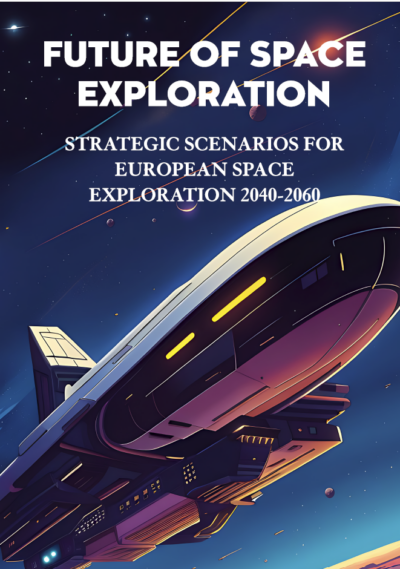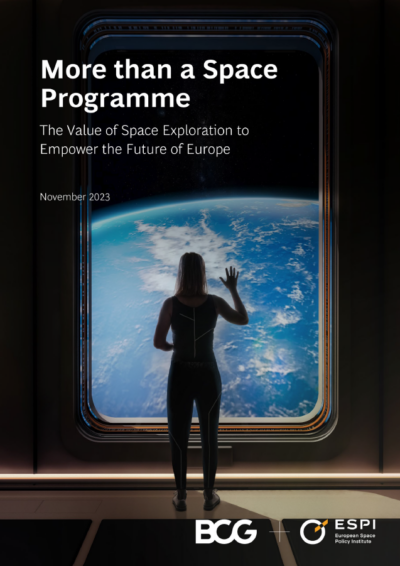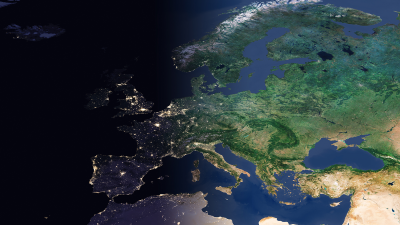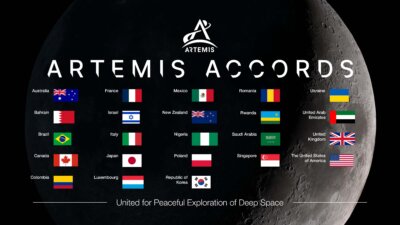Executive Brief No.12
1. Introduction
The signature by Donald Trump on March 25 of NASA’s Transition Authorization Act of 2017, the first comprehensive NASA authorization passed by Congress in more than six years, marks clearly the willingness of the US Congress and the executive to have NASA actively preparing forexpanding “permanent human presence beyond low-Earth orbit,…, in a manner involving international, academic, and industry partners,… and to enable a capability to extend human presence, including potential human habitation on another celestial body and a thriving space economy in the 21st Century”1. It also highlights the unanimous bi-partisan vision for a radically new approach on human space exploration. The final objective being the journey to Mars, but using cis-lunar orbits as an enabler and possibly the Moon as a terrain for experimentation (operations, infrastructure construction, science). Considering that human activity in low-earth orbit (LEO) has brought sufficient experience and knowledge to push the new Frontier one step further, the United States wants to write a new page in human space exploration seizing the opportunity of learning how to work and explore far away from Earth, not having the immediate possibility to return to mother planet. By now, the American mind-set considers realistic to expand the technological and human spheres well beyond the Earth limes.
Such a bold approach poses a series of questions, particularly to Europe: How robust in time is thisnew approach? Are we ready as Europeans to be part of this adventure and, if yes, to what extentsince ESA has proposed its vision for a Moon Village? Or should we establish a cooperation with China to deepen our contribution to LEO space exploration, and possibly to be part of a contemplated permanent Chinese lunar base? Or be part of both endeavours? Because both of these, of a quite different nature, are moving ahead, it is difficult to conceive that Europe would not participate in at least one of them for a range of political, scientific, technical and industrial reasons.
2. The Architecture proposed by NASA
The current plan consists in assembling a 40-ton space station called the Deep Space Gateway (DSG), between 2022 and 2026, manoeuvring on different lunar orbits with the support of a 40-kW solar electric propulsion (SEP), that receives a crew of four and docking with visiting Orion capsuleand interplanetary spacecraft. The DSG would be used by crews departing from lunar orbits to deep space, e.g. to Mars, and as a waypoint on the journey back to Earth. These crews would use a Deep Space Transport (DST) assembled after 2027 via two Space Launch System (SLS) flights to the DSG and getting ready through additional cargo provisions shipped from Earth. The 150-kW SEP-equipped DST would then be used first for a long-term habitation checkout on lunar orbits starting in 2029 before journeying to Mars in the early 2030s, once refuelled and stocked with consumables delivered by subsequent SLS missions. This plan would involve a total of 12 SLS launches of different versions.
NASA has privileged a step by step approach for preparing the crewed journey to Mars as well as in assembling the DSG and the DSP. This for safety reasons and also to provide sufficient flexibility for eventual reconfigurations resulting from lessons learned in the unwinding process. Other views may suggest a more economic approach2 in terms of mass budget in LEO, crewed flights and expenses, but which may under-estimate risk taking through the different steps.
William Gerstenmaier, NASA’s associate administrator for human exploration and operations, indicated that the DSG and DST concepts were briefed to the agency’s Advisory Council on March 28th as NASA prepares to submit a detailed budget request in May. In parallel, major space contractors, such as Boeing and Lockheed Martin, have already phase-2 contracts with NASA’s NextSTEP public-private partnerships to develop ground prototypes of several modules3.
Besides this NASA-led effort, one must also keep in mind the programme that SpaceX is putting together to fly-by to the Moon shortly and return, land on Mars in the coming years and to orbit the Red Planed next decade, laying down the first elements of a massive undertaking destined to start colonization of Mars in the 2040s. Blue Origin is also planning Mars travels in the same time frame.
3. What place for Europe?
In light of these developments in the United States, as well as those undergoing in China to pave the way for the construction of the Soviet-Russian Mir-class Tiangong space station in LEO, to be completed by 2022-23, what should be the position of Europe which has no plans of its own ofcomparable breath for the moment? Indeed, at this stage, the proposed Moon Village by ESA’s Director General is a vision which requires an implementation process to be developed and endorsed by ESA’s member states.
Hence Europe has to address the strategic issue of human space exploration for the coming decades: how far are we ready to commit into this human endeavour considering that the ISS is approaching its last stretch of life? At this stage, the answer, based on December 2016 ESA’s ministerial council decisions, and on the October 2016 EC communication on Space strategy for Europe4, calling for taking a much stronger role on the world stage but regrettably not addressing human space exploration, is that Europeans, in our view, are not (yet?) ready to change gears in space exploration. Yet, European space agencies and companies are involved through international cooperation in the robotic scientific exploration of the solar system and in the ISS, to the extent to be on the critical path of the development of the Orion spaceship via its service module. However, they are not part of these new endeavours unfolding in the United States and in China. The planned 2019 ESA Council at ministerial level in Spain would probably be the next opportunity to firm up a European strategy / policy on this matter. This would also be timely because we will have a much clearer view as to how the proposed deep space architectures are materialising and funded as well as how the Chinese programme is unwinding.
The European strategy may be drawn along the following lines:
• Considering NASA’s plans, Europe could contribute to a second Orion capsule (Lockheed Martin project would take two Orions to Mars), manufacture one of the four DSG modulesto be assembled on a Cis-lunar Near Rectilinear Halo Orbit in the first half of the next decade, prepare astronauts to crew the DSG, take advantage of the DSG for preparing concrete elements part of the Moon Village,…
It is reasonable to assume that once the 2018 NASA budget is approved, NASA will engage discussions with international partners for their contributions, both to alleviate the US budget burden and to benefit from recognized specific competences (for instance, Canadian excellence in robotic arms, European Columbus module contribution to the ISS). ESA, European national space agencies and industry should be prepared for suchexploratory talks, and European governments, in a contemplated international agreement that could resemble to the ISS model, should secure shares of the future space exploration market for European industries and ensure long-term stability of the programme through mutual binding commitments.
• If Europe does not feel ready to participate in the plans NASA is fleshing out, but still wants to pursue human space exploration in the post-ISS era, it should then consider how it could be part of LEO exploration on the Chinese Space Station (CSS) via experiments, and astronauts participation for instance. This could be seen as a natural continuation of the Columbus experience based on affordable budgets, learning to work in a different space environment, sharing European manned space knowledge with Chinese experts. If retained, it would contrast sharply with the policy conducted so far for human space exploration cooperation by the Europeans and would require therefore a political decision at the highest level.
• Further, one could also imagine Europe participating to both the American and Chinese ventures. But this then should imply that we would have sufficient budgetary and human resources to be a significant actor-otherwise it would be useless to participate- in each of these international cooperation, which is, under the current foreseeable resources, unlikely.
4. Conclusion
The United states, if their plans mature, will engage in space exploration on a broad scale, adding manned deep space exploration to their fleet of robotic missions, at least for the closest main celestial bodies to the Earth. It is a dramatic step in the extension of the human habitat in space, pushing a new frontier, opening new avenues preparing possibly to future commercial exploitation of space. Providing this is firmed up, the question for Europe is very simple: do Europeans want to be part of it or not? If yes, be ready to grab this one-time opportunity in preparing its technical, scientific and human contributions right now which may imply hard choices on existing or planned programmes, as well as facing the risk that the US endeavour be abandonned in a few years as this has happened in the past to other US-led initiatives. Yet, if as early as possible an international montage, robust enough, is crafted, we should have sufficient guaranties to build up the necessary resilience to face political, geopolitical and budgetary hurdles. After all, the ISS has proven successful in that regard.Quoting John F. Kennedy in his speech to a joint session of Congress in May 1961, where the Apollo programme was anounced, but not applying his words to the space race, Europeans should reflect on “the impact of this [space] adventure on the minds of men everywhere, who are attempting to make a determination of which road they should take”.
1 National Aeronautics and Space Administration Transition Authorization Act of 2017;
https://www.congress.gov/bill/115th-congress/senate-bill/442/text
2 An alternative architecture for deep space exploration using SLS and Orion, Ari Allyn-Freuer, The Space Review, April 17, 2017; http://www.thespacereview.com/article/3220/1
3 Selling the Gateway, Frank Morring. Jr, Aviation Week & Space Technology, p. 22, April 17-30, 2017
4 Communication on a Space Strategy for Europe; 26 October 2016
https://ec.europa.eu/transparency/regdoc/rep/1/…/COM-2016-705-F1-EN-MAIN.PD




